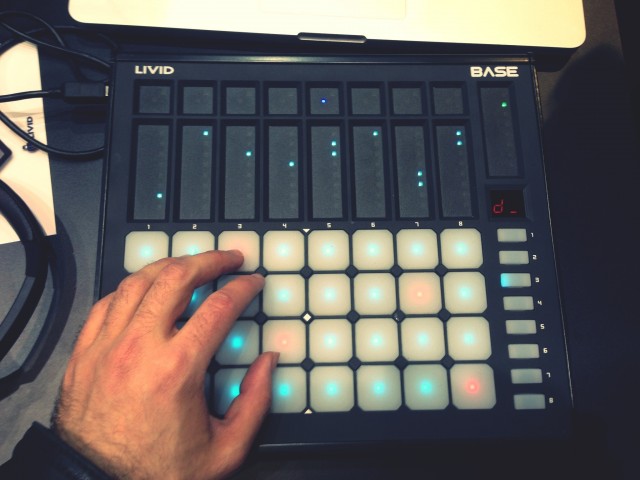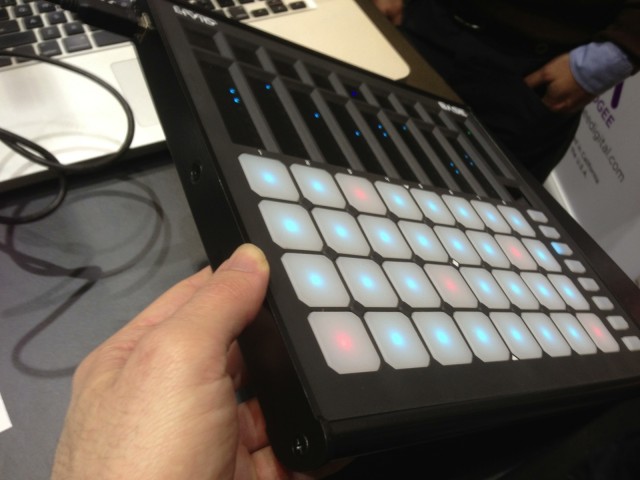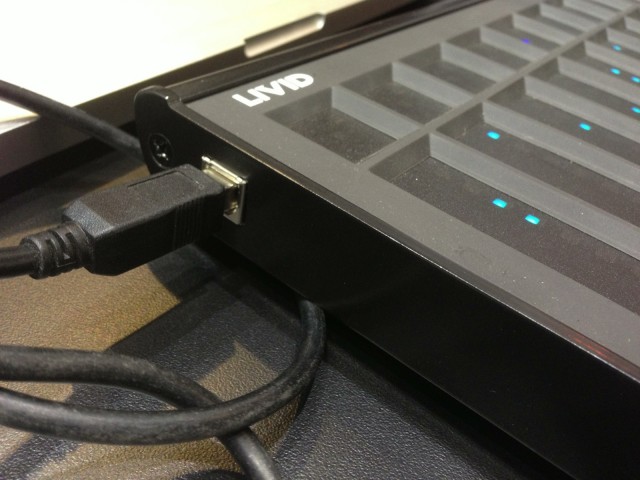One highlight of Musikmesse for me was getting to catch up with Jay Smith of Livid Instruments. Base, their touch controller (grid plus touch strips), is even more appealing in person than online. And it seems like it could really sit in a niche in controllers, even with lots of grids out there these days.
By comparison, Novation’s new Launchpad S, while much cheaper, lacks pressure sensitivity. And Ableton’s Push also leaves plenty of room for Base. Push I still think is a terrific controller, even as it has some growing pains with its initial launch – I’ve had some readers complaining about hardware variations like off-color RGB LEDs, and you just can’t buy the thing for some time. But more importantly, while Push is a beautiful piece of hardware and has the deepest integration with Live, you might want something simpler and more generic. Others must agree: even with Push announced, Base sold out its initial handmade run. There just seems to be an insatiable appetite for all these controllers, and of course no one size fits everyone.
Livid’s Base has dedicated vertical faders, which Push and Launchpad lack. The grid is pressure sensitive, of course. And you get the ability to send note on and note off values (with velocity) from the sliders, too, so you could devise new instrumental applications for them. And it’s tough to overstate just how portable this is. With nice metal sides, crafted in Livid’s facility in Austin, Texas, and no moving parts, it’s a no-brainer to drop this into a backpack or messenger bag – even ones too small for Push.
The simplified layout – grid, bank buttons, faders – lends itself nicely to mappings. Jay showed me the Base’s Ableton Live mappings, and I think they’re brilliant. Bank buttons switch you between clip triggering, drums, and instruments, and the faders easily access mix, sends, and Device parameters. And you still get step sequencing. I think Push is a lot deeper in the studio, but while it works live, it can be a bit complex to navigate in that scenario. And that’s before we get into the possibility of using Base with other software. First, a look as Jay walks us through the Ableton mappings:
Other software, you say? One example: Bitwig was also at Musikmesse, so as I stopped back by the booth, Jay had just installed a new Bitwig Studio control script they’d given him. One of the nice things about Bitwig Studio is its JavaScript controller support. Of course, Bitwig still isn’t publicly available, but insert your own favorite software here.
Here’s a terrible video proving that the script works, and not much else. (Apologies – Jay and I hadn’t really had time to look at the controller, so just figure this is visual evidence that … there is a script. I expect there’s a Base sitting here in Berlin at Bitwig. We really need to all get together and have a massive grid hackday with monome and Push and Launchpad and Base and as much music and visual software as we can organize.)
I’m disappointed that there’s nothing other than MIDI control on Base, though. I won’t get into the ups and downs of OSC, but if not OSC, some control protocol would sure be nice, especially given Livid’s focus on the DIYer.
But that’s about the only complaint I can think of. Like Push, Base is sold out at the moment, but a new run is in the works and should be available soon. We’ll be watching.
http://lividinstruments.com/hardware_base.php
Update: Peter Nyboer explains how the touch faders send messages. You can send variable velocity, but using position, not touch sensitivity (which makes more sense, anyway, I think)!
There’s two modes for the note that is sent when you touch the fader: “fixed” and “position.” If fixed, when you touch the fader, a note (of your choice) is sent with velocity 127, then a 0 when released. In position mode, the velocity will be based on the position where you touch the fader, so if you touch it at the bottom, it sends a velocity of 1, if you touch it in the middle, it sends a velocity of 63, and so on. You could say there’s a third mode: “don’t send any note, I just care about the CC!”


